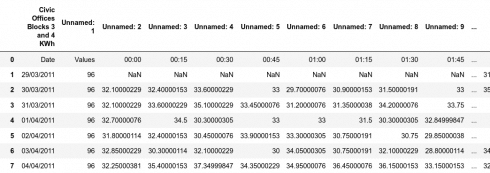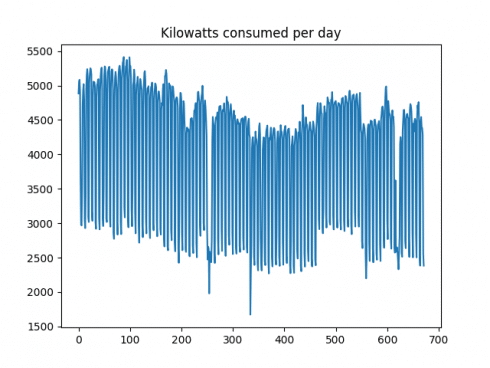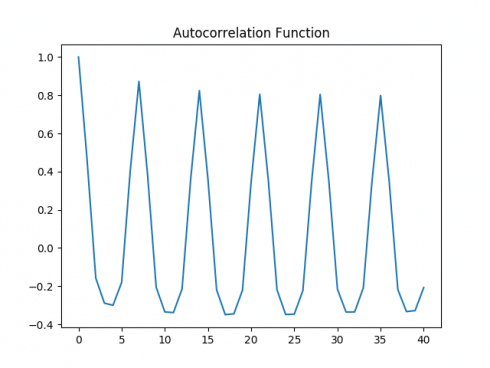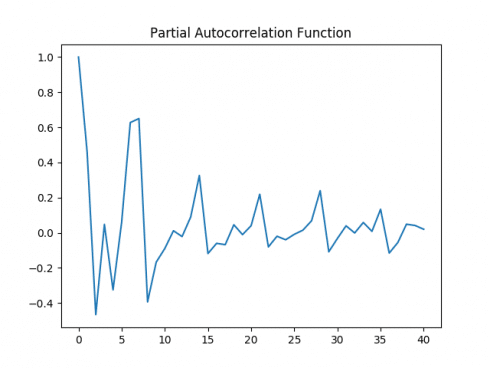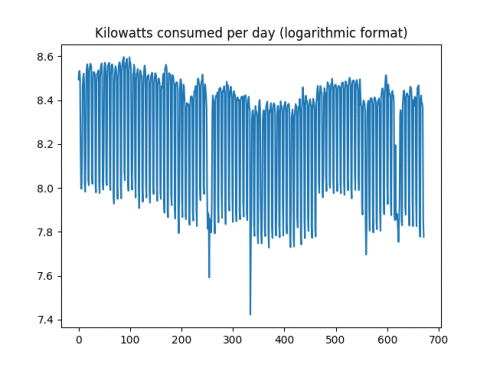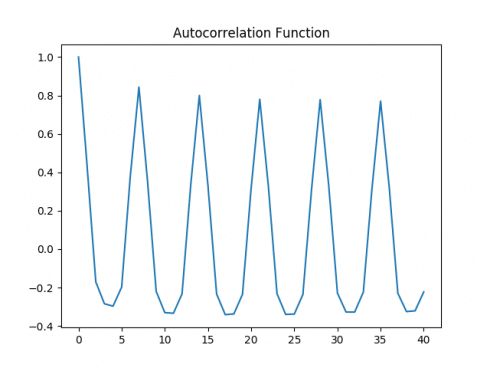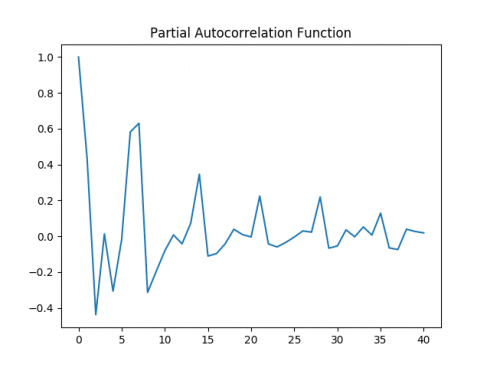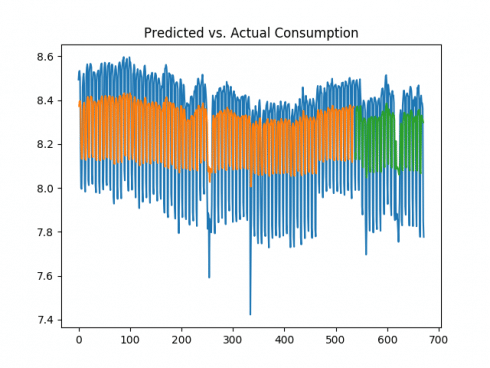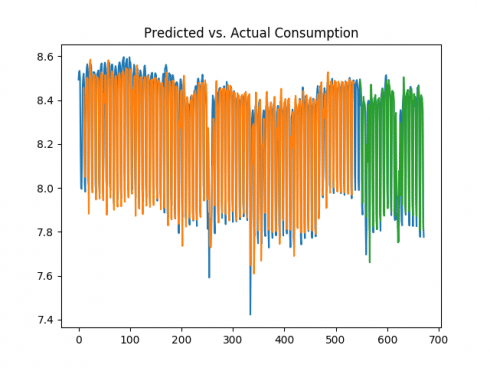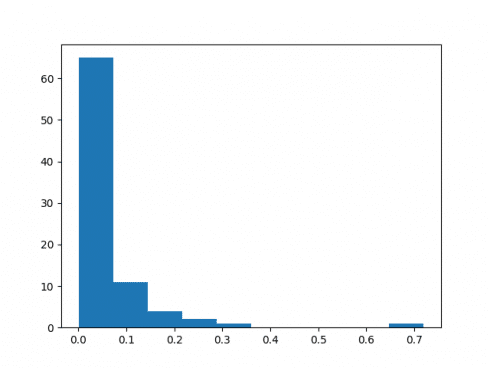Note: This article has since been updated. More recent and up-to-date findings can be found at: ARIMA vs. LSTM: Forecasting Electricity Consumption
In this example, an LSTM neural network is used to forecast energy consumption of the Dublin City Council Civic Offices using data between April 2011 – February 2013. The original dataset is available from data.gov.ie.
Data Processing
Given the data is presented in 15 minute intervals, daily data was created by summing up the consumption for each day across the 15 minute intervals contained in the original dataset, along with the dataset matrix being formed to allow for a specified number of lags to be regressed against electricity consumption at time t. NA values were dropped from the dataset, along with irrelevant columns.
Here is a sample of the original data:
First, the relevant dataset matrix is formed for processing with the LSTM model:
Dataset Matrix
# Form dataset matrix
def create_dataset(dataset, previous=1):
dataX, dataY = [], []
for i in range(len(dataset)-previous-1):
a = dataset[i:(i+previous), 0]
dataX.append(a)
dataY.append(dataset[i + previous, 0])
return np.array(dataX), np.array(dataY)
Then, the data in its original format is cleaned accordingly:
Data Cleaning
# fix random seed for reproducibility
np.random.seed(7)
# load dataset
df = read_csv('dccelectricitycivicsblocks34p20130221-1840.csv', engine='python', skipfooter=3)
df2=df.rename(columns=df.iloc[0])
df3=df2.drop(df.index[0])
df3
df3.drop(df3.index[0])
df4=df3.drop('Date', axis=1)
df5=df4.drop('Values', axis=1)
df5
df6=df5.dropna()
df7=df6.values
df7
dataset=np.sum(df7, axis=1, dtype=float)
dataset
Now, here is a modified numpy array showing the total electricity consumption for each day (with NAs dropped from the model):
Introduction to LSTM
LSTMs (or long-short term memory networks) allow for analysis of sequential or ordered data with long-term dependencies present. Traditional neural networks fall short when it comes to this task, and in this regard an LSTM will be used to predict electricity consumption patterns in this instance. One particular advantage of LSTMs compared to models such as ARIMA, is that the data does not necessarily need to be stationary (constant mean, variance, and autocorrelation), in order for LSTM to analyse the same – even if doing so might result in an increase in performance.
Autocorrelation Plots, Dickey-Fuller test and Log-Transformation
In order to determine whether stationarity is present in our model:
- Autocorrelation and partial autocorrelation plots are generated
- A Dickey-Fuller test is conducted
- The time series is log-transformed and the above two procedures are run once again in order to determine the change (if any) in stationarity
Firstly, here is a plot of the time series:
It is observed that the volatility (or change in consumption from one day to the next) is quite high. In this regard, a logarithmic transformation could be of use in attempting to smooth this data somewhat. Before doing so, the ACF and PACF plots are generated, and a Dickey-Fuller test is conducted.
Autocorrelation Plot
Partial Autocorrelation Plot
Both the autocorrelation and partial autocorrelation plots exhibit significant volatility, implying that correlations exist across several intervals in the time series. A Dickey-Fuller test is run:
result = adfuller(data1)
print('ADF Statistic: %f' % result[0])
ADF Statistic: -2.703927
print('p-value: %f' % result[1])
p-value: 0.073361
print('Critical Values:')
Critical Values:
for key, value in result[4].items():
print('\t%s: %.3f' % (key, value))
Here is the output:
Output
1%: -3.440
5%: -2.866
10%: -2.569
With a p-value above 0.05, the null hypothesis of non-stationarity cannot be rejected.
>>> std1=np.std(dataset) >>> mean1=np.mean(dataset) >>> cv1=std1/mean1 #Coefficient of Variation >>> std1 954.7248 >>> mean1 4043.4302 >>> cv1 0.23611754
The coefficient of variation (or mean divided by standard deviation) is 0.236, demonstrating significant volatility in the series. Now, the data is transformed into logarithmic format.
from numpy import log dataset = log(dataset)
While the time series remains volatile, the size of the deviations have decreased slightly when expressed in logarithmic format:
Moreover, the coefficient of variation has decreased significantly to 0.0319, implying that the variability of the trend in relation to the mean is significantly lower than previously.
>>> std2=np.std(dataset) >>> mean2=np.mean(dataset) >>> cv2=std2/mean2 #Coefficient of Variation >>> std2 0.26462445 >>> mean2 8.272395 >>> cv2 0.031988855
Again, ACF and PACF plots are generated on the logarithmic data, and a Dickey-Fuller test is conducted once again.
Autocorrelation Plot
Partial Autocorrelation Plot
Dickey-Fuller Test
>>> # Dickey-Fuller Test
... result = adfuller(logdataset)
>>> print('ADF Statistic: %f' % result[0])
ADF Statistic: -2.804265
>>> print('p-value: %f' % result[1])
p-value: 0.057667
>>> print('Critical Values:')
Critical Values:
>>> for key, value in result[4].items():
... print('\t%s: %.3f' % (key, value))
...
1%: -3.440
5%: -2.866
10%: -2.569
The p-value for the Dickey-Fuller test has decreased to 0.0576. While this technically does not enter the 5% level of significance threshold necessary to reject the null hypothesis, the logarithmic time series has shown lower volatility based on the CV metric, and therefore this time series is used for forecasting purposes with LSTM.
Time Series Analysis with LSTM
Now, the LSTM model itself is used for forecasting purposes.
Data Processing
Firstly, the relevant libraries are imported and data processing is carried out:
import numpy as np import matplotlib.pyplot as plt from pandas import read_csv import math import pylab from keras.models import Sequential from keras.layers import Dense from keras.layers import LSTM from pandas import Series from sklearn.preprocessing import MinMaxScaler from sklearn.metrics import mean_squared_error import os; path="filepath" os.chdir(path) os.getcwd()
The data is now normalised for analysis with the LSTM model:
from numpy import log dataset = log(dataset) meankwh=np.mean(dataset) # normalize dataset with MinMaxScaler scaler = MinMaxScaler(feature_range=(0, 1)) dataset = scaler.fit_transform(dataset) # Training and Test data partition train_size = int(len(dataset) * 0.8) test_size = len(dataset) - train_size train, test = dataset[0:train_size,:], dataset[train_size:len(dataset),:] # reshape into X=t-50 and Y=t previous = 50 X_train, Y_train = create_dataset(train, previous) X_test, Y_test = create_dataset(test, previous) # reshape input to be [samples, time steps, features] X_train = np.reshape(X_train, (X_train.shape[0], 1, X_train.shape[1])) X_test = np.reshape(X_test, (X_test.shape[0], 1, X_test.shape[1]))
LSTM Generation and Predictions
The model is trained over 100 epochs, and the predictions are generated.
model = Sequential()
model.add(LSTM(4, input_shape=(1, previous)))
model.add(Dense(1))
model.compile(loss='mean_squared_error', optimizer='adam')
model.fit(X_train, Y_train, epochs=100, batch_size=1, verbose=2)
trainpred = model.predict(X_train)
testpred = model.predict(X_test)
trainpred = scaler.inverse_transform(trainpred)
Y_train = scaler.inverse_transform([Y_train])
testpred = scaler.inverse_transform(testpred)
Y_test = scaler.inverse_transform([Y_test])
predictions = testpred
trainScore = math.sqrt(mean_squared_error(Y_train[0], trainpred[:,0]))
print('Train Score: %.2f RMSE' % (trainScore))
testScore = math.sqrt(mean_squared_error(Y_test[0], testpred[:,0]))
print('Test Score: %.2f RMSE' % (testScore))
trainpredPlot = np.empty_like(dataset)
trainpredPlot[:, :] = np.nan
trainpredPlot[previous:len(trainpred)+previous, :] = trainpred
testpredPlot = np.empty_like(dataset)
testpredPlot[:, :] = np.nan
testpredPlot[len(trainpred)+(previous*2)+1:len(dataset)-1, :] = testpred
inversetransform, =plt.plot(scaler.inverse_transform(dataset))
trainpred, =plt.plot(trainpredPlot)
testpred, =plt.plot(testpredPlot)
plt.title("Predicted vs. Actual Consumption")
plt.show()
Accuracy
Here is the output when 100 epochs are generated:
Epoch 94/100
- 2s - loss: 0.0406
Epoch 95/100
- 2s - loss: 0.0406
Epoch 96/100
- 2s - loss: 0.0404
Epoch 97/100
- 2s - loss: 0.0406
Epoch 98/100
- 2s - loss: 0.0406
Epoch 99/100
- 2s - loss: 0.0403
Epoch 100/100
- 2s - loss: 0.0406
>>> # Generate predictions
... trainpred = model.predict(X_train)
>>> testpred = model.predict(X_test)
>>>
>>> # Convert predictions back to normal values
... trainpred = scaler.inverse_transform(trainpred)
>>> Y_train = scaler.inverse_transform([Y_train])
>>> testpred = scaler.inverse_transform(testpred)
>>> Y_test = scaler.inverse_transform([Y_test])
>>>
>>> # calculate RMSE
... trainScore = math.sqrt(mean_squared_error(Y_train[0], trainpred[:,0]))
>>> print('Train Score: %.2f RMSE' % (trainScore))
Train Score: 0.24 RMSE
>>> testScore = math.sqrt(mean_squared_error(Y_test[0], testpred[:,0]))
>>> print('Test Score: %.2f RMSE' % (testScore))
Test Score: 0.23 RMSE
The model shows a root mean squared error of 0.24 on the training dataset, and 0.23 on the test dataset. The mean kilowatt consumption (expressed in logarithmic format) is 8.27, which means that the error of 0.23 represents less than 3% of the mean consumption. Here is the plot of predicted versus actual consumption:
Interestingly, when the predictions are generated on the raw data (not converted into logarithmic format), the following training and test errors are yielded:
>>> # calculate RMSE
... trainScore = math.sqrt(mean_squared_error(Y_train[0], trainpred[:,0]))
>>> print('Train Score: %.2f RMSE' % (trainScore))
Train Score: 840.95 RMSE
>>> testScore = math.sqrt(mean_squared_error(Y_test[0], testpred[:,0]))
>>> print('Test Score: %.2f RMSE' % (testScore))
Test Score: 802.62 RMSE
In the context of a mean consumption of 4043 kilowatts per day, the mean squared error for the test score represents nearly 20% of the total mean daily consumption, and is quite high in comparison to that generated on the logarithmic data. That said, it is important to bear in mind that the prediction was made using 1-day of previous data, i.e. Y represents consumption at time t, while X represents consumption at time t-1, as set by the previous variable in the code previously. Let’s see what happens if this is increased to 10 and 50 days.
10 days
>>> # calculate RMSE
... trainScore = math.sqrt(mean_squared_error(Y_train[0], trainpred[:,0]))
>>> print('Train Score: %.2f RMSE' % (trainScore))
Train Score: 0.08 RMSE
>>> testScore = math.sqrt(mean_squared_error(Y_test[0], testpred[:,0]))
>>> print('Test Score: %.2f RMSE' % (testScore))
Test Score: 0.10 RMSE
50 days
>>> print('Train Score: %.2f RMSE' % (trainScore))
Train Score: 0.07 RMSE
>>> testScore = math.sqrt(mean_squared_error(Y_test[0], testpred[:,0]))
>>> print('Test Score: %.2f RMSE' % (testScore))
Test Score: 0.11 RMSE
We can see that the test error was significantly lower over the 10 and 50-day periods, and the volatility in consumption was much better captured given that the LSTM model took more historical data into account when forecasting. Given the data is in logarithmic format, it is now possible to obtain the true values of the predictions by obtaining the exponent of the data. For instance, the predictions variable (or test predictions) is reshaped with (1, -1):
>>> predictions.reshape(1,-1) array([[7.7722197, 8.277015 , 8.458941 , 8.455311 , 8.447589 , 8.445035, ...... 8.425287 , 8.404881 , 8.457063 , 8.423954 , 7.98714 , 7.9003944, 8.240862 , 8.41654 , 8.423854 , 8.437414 , 8.397851 , 7.9047146]], dtype=float32)
Using numpy, the exponent is then calculated:
>>> np.exp(predictions)
array([[2373.7344],
[3932.4375],
[4717.062 ],
......
[4616.6016],
[4437.52 ],
[2710.0288]], dtype=float32)
Upon transforming the predictions back to the original format through calculating the exponent, we are now in a position to calculate the percentage error between the predicted and actual consumption, and plot a histogram of the percentage errors.
>>> percentage_error=((predictions-Y_test)/Y_test)
>>> percentage_error=abs(percentage_error)
>>> mean=np.mean(percentage_error)
>>> mean
0.061858222621514226
>>> percentage_error=pd.DataFrame(percentage_error)
>>> below10=percentage_error[percentage_error < 0.10].count()
>>> all=percentage_error.count()
>>> np.sum(below10)
71
>>> np.sum(all)
84
>>> plt.hist(percentage_error)
(array([65., 11., 4., 2., 1., 0., 0., 0., 0., 1.]), array([3.24421771e-04, 7.22886782e-02, 1.44252935e-01, 2.16217191e-01,
2.88181447e-01, 3.60145704e-01, 4.32109960e-01, 5.04074217e-01,
5.76038473e-01, 6.48002729e-01, 7.19966986e-01]), <a list of 10 Patch objects>)
>>> plt.show()
71 of the 84 predictions showed a deviation of less than 10%. Moreover, the mean percentage error was 6.1%, indicating that the model did quite a good job at forecasting electricity consumption.
Here is a histogram of the percentage errors, illustrating that the majority are below 10%:
Conclusion
For this example, LSTM proved to be quite accurate at predicting fluctuations in electricity consumption. Moreover, expressing the time series in logarithmic format allowed for a smoothing of the volatility in the data and improved the prediction accuracy of the LSTM.
